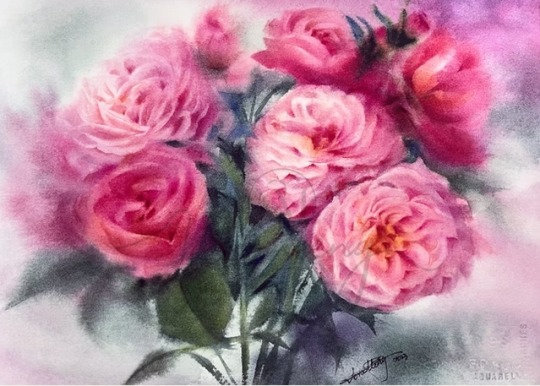Don't wanna be here? Send us removal request.
Text
Painting Course: A Comprehensive Guide to Mastering the Art of Painting

Introduction to Painting Course
Painting is a timeless form of artistic expression that allows individuals to convey emotions, ideas, and stories through colors, textures, and brushstrokes. Whether you're a beginner or an experienced artist looking to refine your skills, enrolling in a painting course can provide structured learning, expert guidance, and creative inspiration.
This guide explores the benefits of taking a painting course, the different types available, essential techniques, and how to choose the right program for your artistic journey.
Why Enroll in a Painting Course?
Taking a painting course offers numerous advantages, including:
1. Structured Learning
A well-designed painting course provides a step-by-step curriculum, ensuring that students build foundational skills before advancing to complex techniques.
2. Professional Guidance
Experienced instructors offer personalized feedback, helping students correct mistakes and improve their artistic abilities.
3. Exposure to Different Styles
From classical realism to abstract expressionism, a painting course introduces students to various artistic styles, broadening their creative horizons.
4. Access to Quality Materials & Tools
Many courses provide high-quality materials, allowing students to experiment with professional-grade paints, brushes, and canvases.
5. Community & Collaboration
Joining a painting course connects artists with like-minded individuals, fostering creativity through group discussions and collaborative projects.
Types of Painting Courses Available
Depending on your interests and skill level, you can choose from several types of painting courses:
1. Beginner Painting Courses
These courses focus on fundamental skills such as color mixing, brush techniques, and basic composition. Ideal for those new to painting.
2. Intermediate & Advanced Painting Courses
Designed for artists with some experience, these programs delve into advanced techniques like glazing, impasto, and dynamic compositions.
3. Oil Painting Courses
Oil paints are versatile and rich in texture. A specialized oil painting course teaches blending, layering, and drying techniques unique to this medium.
4. Watercolor Painting Courses
Watercolors require precision and control. A watercolor painting course covers washes, gradients, and transparency effects.
5. Acrylic Painting Courses
Acrylics dry quickly and are highly adaptable. An acrylic painting course explores texture building, layering, and mixed-media applications.
6. Digital Painting Courses
For those interested in modern art forms, a digital painting course teaches techniques using software like Adobe Photoshop and Procreate.
7. Landscape & Portrait Painting Courses
Specialized courses focus on capturing nature or human expressions, teaching perspective, shading, and anatomical accuracy.
Essential Techniques Taught in a Painting Course
A high-quality painting course covers key techniques to enhance artistic proficiency:
1. Color Theory & Mixing
Understanding primary, secondary, and tertiary colors, as well as warm and cool tones, is crucial for creating harmonious artworks.
2. Brushwork & Strokes
Different brushes produce varying effects—learning how to use flat, round, and fan brushes enhances control and creativity.
3. Composition & Perspective
A strong composition guides the viewer’s eye. Courses teach the rule of thirds, focal points, and depth techniques.
4. Light & Shadow
Mastering chiaroscuro (light and shadow) adds realism and dimension to paintings.
5. Texture & Layering
Techniques like dry brushing, sgraffito, and impasto help create tactile surfaces in artwork.
6. Drying & Varnishing
Proper drying methods and varnish application ensure the longevity of oil and acrylic paintings.
How to Choose the Right Painting Course
Selecting the best painting course depends on several factors:
1. Skill Level
Choose a course that matches your experience—beginner, intermediate, or advanced.
2. Medium Preference
Decide whether you want to focus on oils, watercolors, acrylics, or digital painting.
3. Instructor Expertise
Research the instructor’s background, artistic style, and teaching approach.
4. Course Format
Options include in-person classes, online courses, or hybrid programs.
5. Duration & Schedule
Short workshops are great for quick learning, while long-term courses provide in-depth training.
6. Reviews & Testimonials
Check student feedback to gauge the course’s effectiveness and instructor quality.
Top Platforms Offering Painting Courses
Several reputable platforms provide excellent painting courses:
Udemy – Affordable courses on various painting styles.
Coursera – University-level art programs.
Skillshare – Creative classes for all levels.
Domestika – Specialized courses by professional artists.
Local Art Schools – Hands-on training with experienced mentors.
Conclusion
A painting course is an invaluable resource for anyone looking to develop their artistic skills. Whether you prefer traditional mediums like oil and watercolor or modern digital painting, structured learning can accelerate your growth as an artist. By selecting the right course, practicing consistently, and embracing creativity, you can unlock your full potential in the world of painting.
Start your artistic journey today by enrolling in a painting course that aligns with your goals and passions!
1 note
·
View note